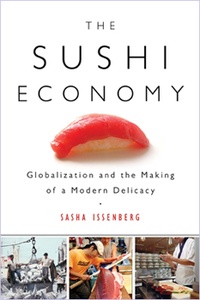A piece of raw fish sitting on a small ball of rice.
At first glance, it seems an unlikely tool for understanding the complex dynamics of global economics.
But as author and journalist Sasha Issenberg discovered, a look at the business behind sushi reveals an intricate web of cultures, industries and money. Sushi, says Issenberg, provides a compelling view of how dramatically the world is changing.
Issenberg’s new book, The Sushi Economy: Globalization and the Making of a Modern Delicacy, explores the world of sushi—and its reflections of the world at large. The author spent two years working on the book, traveling abroad and sampling sushi in 14 countries on five continents. Through an engaging series of character studies, The Sushi Economy profiles people around the globe whose lives have been affected by the valuable culinary commodity.
Praised as much for its provocative insights into global trade as for its human storytelling, the book has received enthusiastic reviews from both literary critics and contemporary business magazines such as Wired and Fast Company.
“I was surprised when I went to Japan a few months ago to give some talks about the book how much interest there was from Japanese media and readers, and how much of this story of sushi was unknown to them or had never been told fully there,” says Issenberg. “Often topics like this one suffer from the fact that the people who write about food aren’t curious about business and people who write about business or economics don’t treat food as a serious subject.”
Sushi, Issenberg argues, is very serious. It breaks many rules of modern commerce yet has become a worldwide phenomenon.
“Sushi appears to defy a lot of the traits that people describe as essential to global business, and especially food culture,” he explains. “It is not centered in the United States, its change is not driven by corporate expansion, and it does not largely benefit from economies of scale. This is all because the product—fresh fish, and in the story I tell in my book, particularly tuna—does not lend itself to be easily standardized, branded or mass-produced. So those who deal in fish for the sushi market are left to rely on personal ties, trust, and local knowledge—the types of old-fashioned human skills that are supposed to have been rendered irrelevant by globalization.”
Those “people qualities” are depicted in a variety of vignettes featuring a range of colorful individuals Issenberg encountered while researching the book. Among the stories is that of Tyson Cole, a University of Texas physics major who was struggling to work his way through college. After Cole applied for 50 jobs, the only offer he received was for a position as a dishwasher at a Japanese restaurant in Austin.
Fascinated by the sushi chefs’ competitive focus on speed and skill, Cole dropped out of school to pursue a career as a sushi chef—not the easiest choice for a young Caucasian military brat working in a profession dominated by Japanese. Occasionally, diners refused to order from him because he was white. He had to plead with his Japanese restaurant boss to be allowed to become a chef, only to be forced to work with his face hidden from the customers’ view for fear that the restaurant’s credibility would be damaged if he was the one being seen preparing the food. Eventually, Cole became a savvy master sushi chef with his own thriving restaurant in Austin.
Issenberg notes that stories like this permeate countless other American states.
“There are many places in the U.S.—Los Angeles and New York, certainly—where sushi is far more prevalent than it is in Japan,” Issenberg observes. “The idea of eating sushi several times a week, which is not uncommon among Americans, would be seen as really unusual in Japan. Now, with conveyor-belt kaiten-sushi, the food is far more accessible and inexpensive than it was a generation ago, but it still has something of an image as a special-occasion food: that a trip to the sushi bar is to be saved for a birthday or a business meeting.”
“Steakhouses fill a similar role in restaurant culture here,” he adds. “We think of them as the classic American establishment, but most of us don’t eat at them all too frequently.”
“As I tried to uncover sushi’s origins in the United States, it kept on coming back to Los Angeles—where I realized not only did the first American sushi bar open, but it was also the first place that sushi seemed to fully find its place in American food culture,” Issenberg says.
“Unfortunately, restaurants and chefs often come and go without much of a record, but two of the companies that were influential in the growth of sushi in the U.S., Mutual Trading and International Marine Products of the EIWA group, have both done a good job of documenting their corporate histories,” says Issenberg. “Their archives and files were helpful to me in reconstructing the wider history of sushi on both sides of the Atlantic, as were interviews with their executives and employees in Los Angeles, New York, and Tokyo.”
The future, says Issenberg, will continue to bring significant change to the sushi economy. One of his interviewees, a fisheries trade specialist, predicts that China will soon become a dominant player in the industry, as Chinese demand for premium tuna grows.
“Americans are led to believe that sushi is an ancient Japanese ritual untouched by time,” says Issenberg. “In fact, I hope to show with the story I tell, it is very much a creation of the modern commercial world.”
* This article was originally published on the Japanese American National Museum Store Online.
© 2007 Japanese American National Museum







